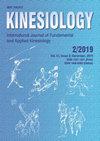Analysis of training load and performance in designing smart bodyweight power training
IF 0.9
4区 医学
Q4 REHABILITATION
引用次数: 0
Abstract
The purpose of this study was to investigate the role of set structures in designing bodyweight power training (BWPT). Specifically, we compared the effects of Cluster set structure undulating variant (CSSUV) and Traditional set structure (TSS) on training load and performance during vertical jumping sessions. Sixteen active males participated in this study. We designed four training sessions that consisted of 144 countermovement jumps distributed into 12 sets, where number of repetitions varied for CSSUV sessions’, and for TSS sessions’ was fixed. In addition, both of the applied set structures included sessions with short (i.e., 60 seconds) and long rest periods (i.e., 120 seconds), while training volume was separately analysed for the first six sets (i.e., small volume) and last six sets (i.e., large volume). We calculated external load, internal load and performance variables. The obtained results suggest that CSSUV allows superior utilization of applied external load, reduction of internal load and overall higher performances that are maintained during entire training session compared to TSS. The present study provides important findings about advantages of CSSUV over TSS in terms of external load, internal load and performances during vertical jumping sessions, and therefore, it might be more suitable approach for designing BWPT.智能体重力量训练设计中的训练负荷与性能分析
本研究的目的是探讨组合结构在设计体重力量训练(BWPT)中的作用。具体而言,我们比较了聚类集结构波动变体(CSSUV)和传统集结构(TSS)对垂直跳跃训练负荷和表现的影响。16名活跃的男性参与了这项研究。我们设计了四个训练课程,包括144个反动作跳跃,分布在12组中,其中CSSUV课程的重复次数不同,而TSS课程的重复次数是固定的。此外,两种应用的训练集结构都包括短(即60秒)和长(即120秒)的休息时间,而训练量分别分析了前六组(即小量)和后六组(即大量)的训练量。我们计算了外部负载,内部负载和性能变量。结果表明,与TSS相比,CSSUV可以更好地利用外部负载,减少内部负载,并在整个训练过程中保持更高的整体性能。本研究提供了CSSUV在外载荷、内载荷和垂直跳跃过程中性能优于TSS的重要发现,因此它可能是更适合设计BWPT的方法。
本文章由计算机程序翻译,如有差异,请以英文原文为准。
求助全文
约1分钟内获得全文
求助全文
来源期刊

Kinesiology
REHABILITATION-SPORT SCIENCES
CiteScore
1.90
自引率
8.30%
发文量
16
审稿时长
>12 weeks
期刊介绍:
Kinesiology – International Journal of Fundamental and Applied Kinesiology (print ISSN 1331- 1441, online ISSN 1848-638X) publishes twice a year scientific papers and other written material from kinesiology (a scientific discipline which investigates art and science of human movement; in the meaning and scope close to the idiom “sport sciences”) and other adjacent human sciences focused on sport and exercise, primarily from anthropology (biological and cultural alike), medicine, sociology, psychology, natural sciences and mathematics applied to sport in its broadest sense, history, and others. Contributions of high scientific interest, including also results of theoretical analyses and their practical application in physical education, sport, physical recreation and kinesitherapy, are accepted for publication. The following sections define the scope of the journal: Sport and sports activities, Physical education, Recreation/leisure, Kinesiological anthropology, Training methods, Biology of sport and exercise, Sports medicine and physiology of sport, Biomechanics, History of sport and Book reviews with news.
 求助内容:
求助内容: 应助结果提醒方式:
应助结果提醒方式:


